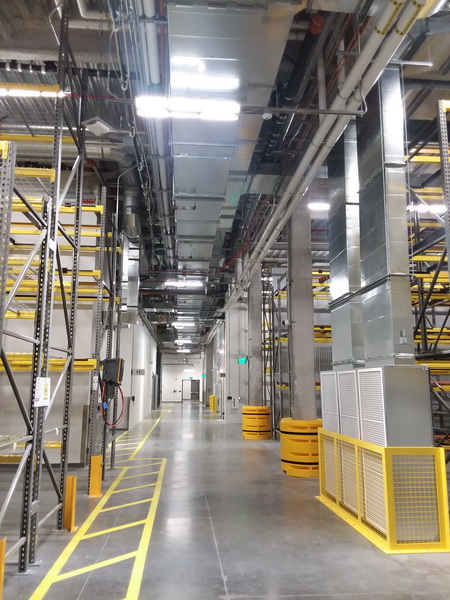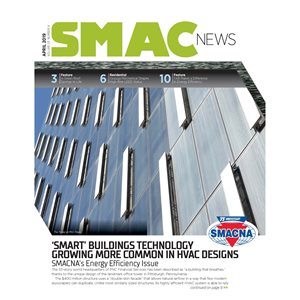San Diego Crime Lab Requires Complex Systems
Associate Mechanical Contractors' complex HVAC system for the San Diego county Crime Lab helped it achieve LEED-Gold status.

The duct system serving the fume hoods.
The Major Crimes and Property and Evidence Unit Building of the San Diego Sheriff’s Crime Lab is one of many laboratory projects on which Associate Mechanical Contractors (AMC) has worked, but this one stands out for its complexity including unique requirements and secure storage conditions.
The crime lab is one of 13 buildings on the county’s main operations campus. The five-story, 160,000 square-foot building houses 200 employees and includes 60,000 square feet of secure evidence and property storage, 54,000 square feet of office space and 44,000 square feet of state-of-the-art laboratory space.
The project included a central plant expansion for the additional requirements of the new crime lab. The basement, which is 25 feet high, contains sensitive evidence and delicate materials that require basement wall waterproofing and a permanent dewatering system.

Supply air ducts for the smoke removal system.
AMC president Rick Reinholz pointed out that the requirements for the crime lab’s air and exhaust systems were exacting. “Typically, if you're in a lab-type environment, you don't have the criminal element requirements on top of it. Just having the security measures for our systems – tamper-proof grills and man bars (for secure ductwork) and other things like protection of sensitive evidence. We're familiar with it, but you don't typically see all those elements mixed together.”
The laboratory exhaust and air handler systems were also used for the smoke evacuation system instead of completely separate air handling and duct systems. “On this project, the engineer designed that to be incorporated within the laboratory exhaust and the comfort cooling air handlers,” said Bruce Robuck, AMC operations manager.
“In the event of a smoke evacuation situation, the air handlers go into smoke evac mode, which shuts down a number of smoke/fire dampers and opens up other smoke/control dampers. The laboratory exhaust system also performs these functions. The engineer did it for space and also to maintain the laboratory conditions in a fire or smoke event,” Robuck explained.
The air handlers in the HVAC system are 100 percent redundant, which keeps occupants inside safe. “Once it's been determined that a carcinogenic or something has gotten loose in the exhaust system, the system switches over to the other air handling system. Those air handlers can continue to service the building while they decontaminate the other part of the building,” he noted.
The project included a mixed flow lab exhaust duct system ranging from ½-inch positive static pressure to 6-inch negative static pressure. The lab exhaust systems were made from welded stainless steel duct to avoid cross contamination of elements.
AMC also provided the mechanical systems for all 900,000 square feet of office space on the campus, which was certified LEED-Gold; the 160,000 square foot crime lab, also certified LEED-Gold; the 15,000 square conference center certified LEED-Platinum, and the 50,000 square-foot fleet facility.
The HVAC equipment AMC installed included:
- 168,000 pounds of galvanized duct and welded stainless steel duct systems.
- 950 registers/diffusers/grills.
- 146 variable air volume boxes and 92 Venturi air valves.
- 54 smoke/fire dampers and 24 low-leak isolation dampers.
- 18 laboratory fume hoods, 33 articulating snorkel arms, and three ventilated bio-safety cabinets.
- Four air handlers totaling 144,000 cubic feet per minute of air flow.
- Four laboratory exhaust fans totaling 104,000 cubic feet per minute of air flow.
- A shooting/gun range exhaust system and a heat and smoke removal system.
Robuck estimates that at the peak of the project AMC had 24 sheet metal workers on-site. The project took 11 months. “We do enjoy working with the county and they're extremely collaborative for a government agency. They take our input and analyze it correctly,” he said.
He credits his trained craftsmen for helping the project go smoothly. “I think it speaks well to our partners and their capabilities. Being union trained, our craftsmen are familiar with these complex systems as opposed to non-union workers. We're typically installing it faster and at a much higher quality,” he said.
Published: April 29, 2019
IN THIS ISSUE
‘Smart’ Buildings Technology Growing More Common in HVAC Designs
Energy efficiency is not just about the environment, its about smart business. This Energy Efficiency Issue covers a myriad of energy efficient projects including Pittsburgh’s groundbreaking PNC Tower – and SMACNA contractors were there to bring it
A Green Roof Springs to Life
On top of a pharmaceutical company’s parking garage in Wilmington, Delaware, there grows a thriving patch of countryside, courtesy of SMACNA member Ernest D. Menold Inc.
Canadian Firm Revamps Plant Exhaust System
Trade-Mark Industrial Inc. of Cambridge, Ontario is flourishing in Canada’s booming economy. Trade-Mark has approximately 1,200 men and women in the field in locations as far west as Manitoba and the United States.
Developing Leaders Through Feedback
Collectively, companies spend billions of dollars for leader development, utilizing everything from public seminars to executive MBA programs at prestigious universities. While all of these have value, people sometimes overlook one of the simplest
Geauga Mechanical Contributes to Luxury High-Rise’s LEED Status
Expertise in energy efficiency and early involvement in the planning process were the keys to a successful residential – and landmark – project for Geauga Mechanical of Chardon, Ohio, according to CEO Craig Berman, LEED AP, CEM.
President’s Column: Building on the Benefits of Energy Efficiency
Today’s emphasis on energy management provides contractors with several opportunities to expand their businesses and help buildings become more energy efficient.
San Diego Crime Lab Requires Complex Systems
Associate Mechanical Contractors' complex HVAC system for the San Diego county Crime Lab helped it achieve LEED-Gold status.
SMACNA Endorses Bipartisan Bill to Speed Hospitality Retrofits
SMACNA has enthusiastically expressed support for the bipartisan bill, Restoring Investments in Improvements Act of 2019 (S. 803), which would amend last year’s Tax Cuts and Jobs Act to boost renovations and retrofits for restaurants and retailers.
Solar Power Harnesses the Sunshine
Roofs can serve multiple purposes besides being the foundation for green roofs. Harnessing the power of the sun, for instance, as a solar energy source for buildings and homes. Some SMACNA contractors are venturing into the solar market, offering
Testing and Balancing: Making a Difference in Energy Efficiency
SMACNA’s testing, adjusting, and balancing contractors are expanding their businesses by focusing on building systems and helping building owners and operators utilize their HVAC systems more efficiently.
University Innovation Center Designed for Collaboration
The roof and façade design for a new academic building project created “the perfect blend of high-tech and natural esthetics” for the University of Maryland’s new Brendan Iribe Center for Computer Science and Engineering, according to Scott Callaway


